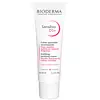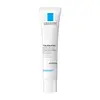Bioderma Sensibio DS+ Cream - Soothing Purifying Cream Versus La Roche-Posay Toleriane Kerium DS Cream
What's inside
What's inside
 Key Ingredients
Key Ingredients

No key ingredients
 Benefits
Benefits

 Concerns
Concerns

 Ingredients Side-by-side
Ingredients Side-by-side

Water
Skin ConditioningCocos Nucifera Oil
MaskingPropylene Glycol
HumectantCaprylic/Capric Triglyceride
MaskingDimethicone
EmollientGlycyrrhetinic Acid
Skin ConditioningSorbitan Sesquioleate
EmulsifyingPiroctone Olamine
PreservativeGlyceryl Undecylenate
EmollientClimbazole
AntimicrobialMannitol
HumectantXylitol
HumectantRhamnose
HumectantFructooligosaccharides
HumectantLaminaria Ochroleuca Extract
Skin ConditioningCetyl Alcohol
EmollientCarbomer
Emulsion StabilisingSclerotium Gum
Emulsion StabilisingSodium Hydroxide
BufferingPhenoxyethanol
PreservativeWater, Cocos Nucifera Oil, Propylene Glycol, Caprylic/Capric Triglyceride, Dimethicone, Glycyrrhetinic Acid, Sorbitan Sesquioleate, Piroctone Olamine, Glyceryl Undecylenate, Climbazole, Mannitol, Xylitol, Rhamnose, Fructooligosaccharides, Laminaria Ochroleuca Extract, Cetyl Alcohol, Carbomer, Sclerotium Gum, Sodium Hydroxide, Phenoxyethanol
Water
Skin ConditioningIsononyl Isononanoate
EmollientGlycerin
HumectantDimethicone
EmollientAmmonium Polyacryloyldimethyl Taurate
Emulsion StabilisingMyristyl Myristate
EmollientStearic Acid
CleansingPotassium Cetyl Phosphate
EmulsifyingZinc PCA
HumectantGlyceryl Stearate Se
EmulsifyingSodium Hydroxide
BufferingMyristic Acid
CleansingPalmitic Acid
EmollientDisodium EDTA
Capryloyl Glycine
CleansingVitreoscilla Ferment
Skin ConditioningCitric Acid
BufferingXanthan Gum
EmulsifyingSodium Benzoate
MaskingPhenoxyethanol
PreservativePiroctone Olamine
PreservativeParfum
MaskingWater, Isononyl Isononanoate, Glycerin, Dimethicone, Ammonium Polyacryloyldimethyl Taurate, Myristyl Myristate, Stearic Acid, Potassium Cetyl Phosphate, Zinc PCA, Glyceryl Stearate Se, Sodium Hydroxide, Myristic Acid, Palmitic Acid, Disodium EDTA, Capryloyl Glycine, Vitreoscilla Ferment, Citric Acid, Xanthan Gum, Sodium Benzoate, Phenoxyethanol, Piroctone Olamine, Parfum
 Reviews
Reviews

Ingredients Explained
These ingredients are found in both products.
Ingredients higher up in an ingredient list are typically present in a larger amount.
Dimethicone is a type of synthetic silicone created from natural materials such as quartz.
What it does:
Dimethicone comes in different viscosities:
Depending on the viscosity, dimethicone has different properties.
Ingredients lists don't always show which type is used, so we recommend reaching out to the brand if you have questions about the viscosity.
This ingredient is unlikely to cause irritation because it does not get absorbed into skin. However, people with silicone allergies should be careful about using this ingredient.
Note: Dimethicone may contribute to pilling. This is because it is not oil or water soluble, so pilling may occur when layered with products. When mixed with heavy oils in a formula, the outcome is also quite greasy.
Learn more about DimethiconePhenoxyethanol is a preservative that has germicide, antimicrobial, and aromatic properties. Studies show that phenoxyethanol can prevent microbial growth. By itself, it has a scent that is similar to that of a rose.
It's often used in formulations along with Caprylyl Glycol to preserve the shelf life of products.
Piroctone Olamine is used to treat fungal infections and often found in anti-dandruff shampoo.
This ingredient is particularly effective against Malassezia, the root cause of dandruff.
Piroctone olamine is water-soluble.
Learn more about Piroctone OlamineSodium Hydroxide is also known as lye or caustic soda. It is used to adjust the pH of products; many ingredients require a specific pH to be effective.
In small amounts, sodium hydroxide is considered safe to use. However, large amounts may cause chemical burns due to its high alkaline.
Your skin has a natural pH and acid mantle. This acid mantle helps prevent harmful bacteria from breaking through. The acid mantle also helps keep your skin hydrated.
"Alkaline" refers to a high pH level. A low pH level would be considered acidic.
Learn more about Sodium HydroxideWater. It's the most common cosmetic ingredient of all. You'll usually see it at the top of ingredient lists, meaning that it makes up the largest part of the product.
So why is it so popular? Water most often acts as a solvent - this means that it helps dissolve other ingredients into the formulation.
You'll also recognize water as that liquid we all need to stay alive. If you see this, drink a glass of water. Stay hydrated!
Learn more about Water